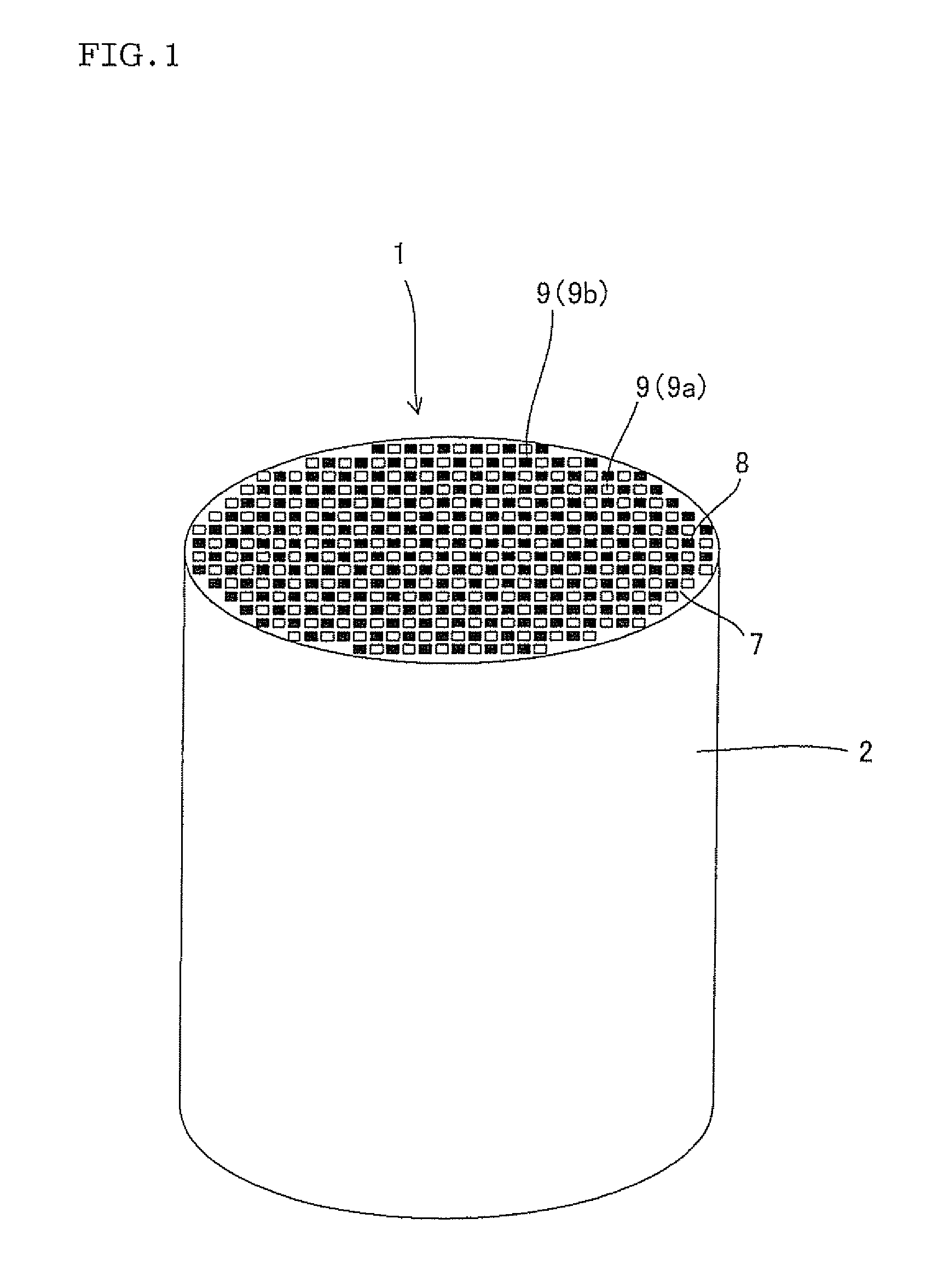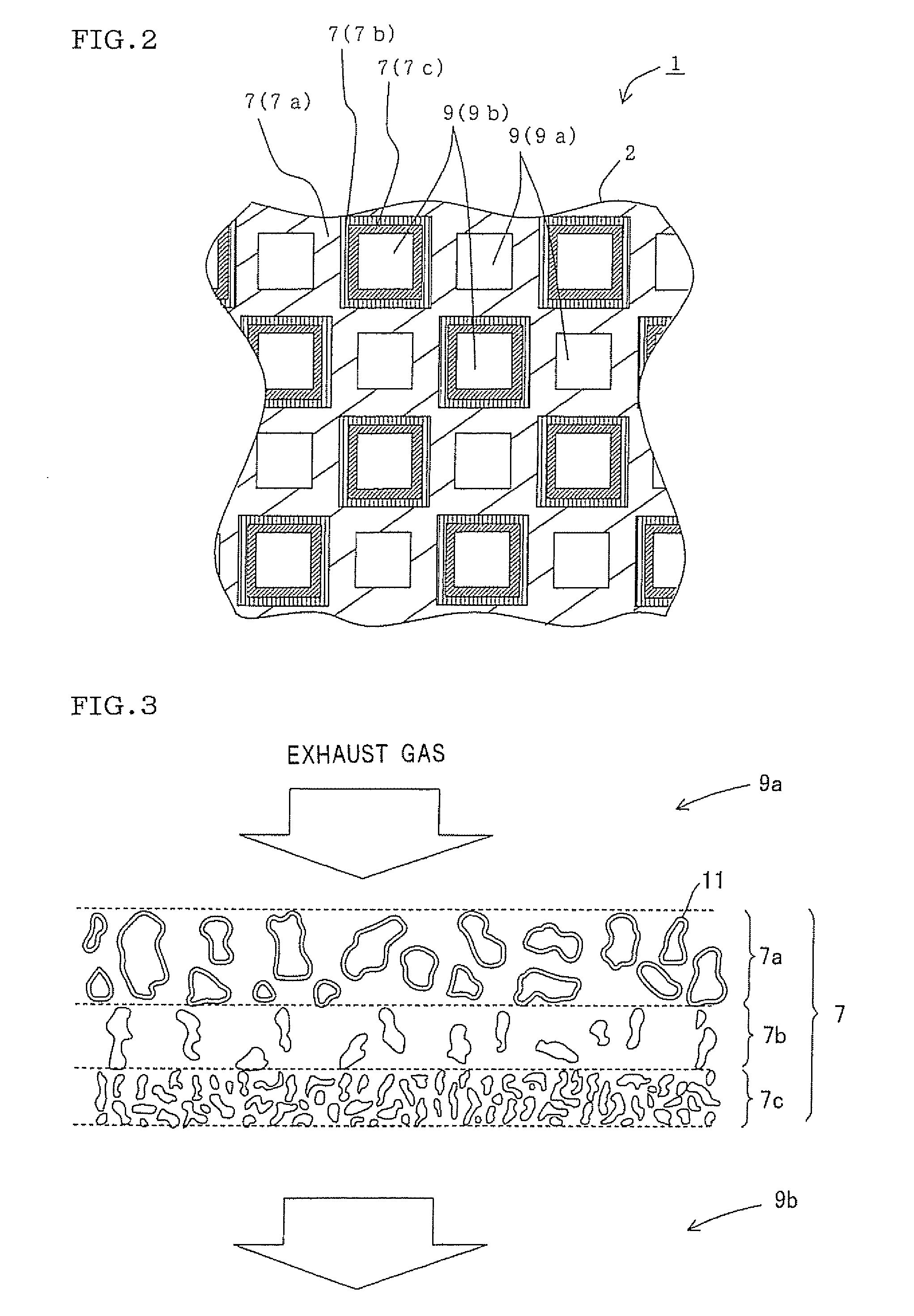Honeycomb filter
a filter and honeycomb technology, applied in the field of honeycomb filters, can solve the problems of unfavorable fuel consumption ratio, increased pressure loss, and deterioration of economic properties, and achieve the effect of satisfying the pressure loss of the whole honeycomb filter, and reducing the risk of deterioration
- Summary
- Abstract
- Description
- Claims
- Application Information
AI Technical Summary
Benefits of technology
Problems solved by technology
Method used
Image
Examples
example 1
[0172]As a honeycomb filter according to Example 1, as shown in FIG. 13, a honeycomb filter 1 was manufactured in which a portion to be the skeleton of a honeycomb structure 2 was constituted of a third wall portion 7c. A second wall portion 7b and a first wall portion 7a were laminated on the front surface of this third wall portion 7c in the thickness direction of a partition wall 7. Furthermore, a fourth wall portion 7d was arranged on the back surface of the third wall portion 7c.
[0173]First, a forming clay for forming a honeycomb structure precursor made of the third wall portion was prepared. The forming clay was prepared by adding 35 parts by mass of water as a dispersion medium and 5 parts by mass of pore former to 100 parts by mass of cordierite forming material, further adding 6 parts by mass of organic binder and 0.5 part by mass of dispersant, and kneading these materials by use of a kneader. As the cordierite forming material, there was used a heretofore known cordieri...
example 8
[0186]As a honeycomb filter of Example 8, a filter having a honeycomb structure in which a portion to be a skeleton of the honeycomb structure was constituted of a third wall portion, and second and first wall portions were laminated on the front surface of this third wall portion in the thickness direction of a partition wall, was manufactured.
[0187]First, a forming clay for forming a honeycomb structure precursor made of the third wall portion was prepared. The forming clay was prepared by adding 36 parts by mass of water as a dispersion medium and 5 parts by mass of pore former to 100 parts by mass of cordierite forming material, further adding 5 parts by mass of organic binder and 0.5 part by mass of dispersant, and kneading these materials by use of a kneader. As the cordierite forming material, a material constituted in the same manner as in the cordierite forming material used in Example 1 was used.
[0188]Subsequently, the obtained forming clay was extruded using a die having ...
example 9
[0197]A honeycomb filter (Example 9) was manufactured which was constituted in the same manner as in Example 8 except that a slurry containing an aluminosilicate fiber was used as a slurry for a first wall portion, this slurry was atomized with an atomizer and sucked together with air from a masked side to form a layer, and this layer was dried to form the first wall portion. A structure of a honeycomb structure in Example 9 is referred to as a structure C. Table 2 shows the hydraulic diameter of a cell, a PM accumulation time, a PM accumulation pressure loss, a PM trapping efficiency, a detected CO amount, and the evaluation result of general evaluation.
PUM
| Property | Measurement | Unit |
|---|---|---|
| pore diameter | aaaaa | aaaaa |
| porosity | aaaaa | aaaaa |
| porosity | aaaaa | aaaaa |
Abstract
Description
Claims
Application Information
 Login to View More
Login to View More - R&D
- Intellectual Property
- Life Sciences
- Materials
- Tech Scout
- Unparalleled Data Quality
- Higher Quality Content
- 60% Fewer Hallucinations
Browse by: Latest US Patents, China's latest patents, Technical Efficacy Thesaurus, Application Domain, Technology Topic, Popular Technical Reports.
© 2025 PatSnap. All rights reserved.Legal|Privacy policy|Modern Slavery Act Transparency Statement|Sitemap|About US| Contact US: help@patsnap.com



